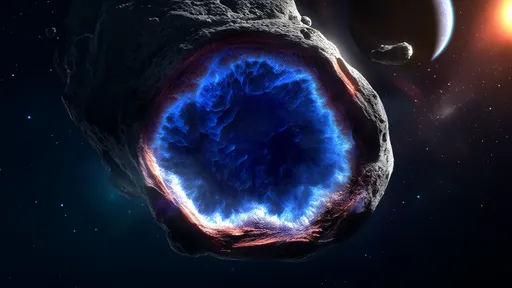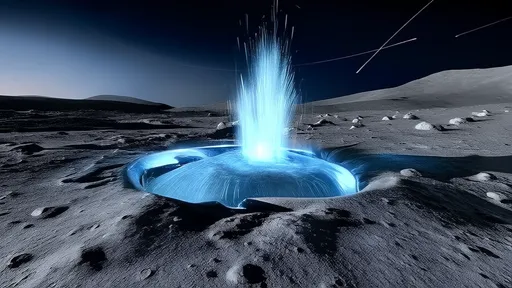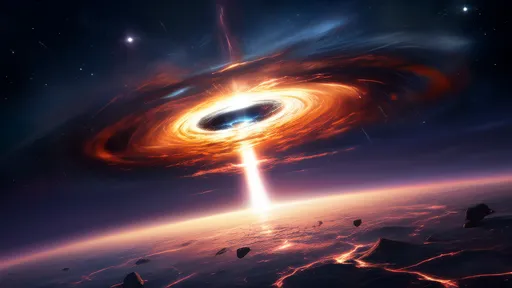The discovery of exoplanets has revolutionized our understanding of planetary systems beyond our own. Among the most fascinating and extreme examples are those worlds where the weather is not just a matter of rain or wind, but of molten rock and superheated storms. These are the lava ocean planets—exotic, hellish worlds where the very skies rage with the fury of a star’s unrelenting heat. Their meteorology is not just a curiosity; it is a window into the most violent and dynamic processes shaping planets across the cosmos.
The Furnace Worlds: A New Frontier in Exoplanet Science
Lava ocean planets, often referred to as "super-Earths" or "sub-Neptunes" depending on their size, orbit so close to their host stars that their surfaces are perpetually molten. Unlike Earth, where weather is driven by water and atmospheric pressure, these worlds experience meteorology forged in fire. Their atmospheres, if they can even be called that, are a seething mix of vaporized rock and metallic gases, creating storms of unimaginable intensity. Telescopes like JWST and Hubble have begun to peel back the layers of these infernos, revealing dynamics that defy terrestrial comparison.
One such world, K2-141b, has become a focal point for researchers. This planet, located hundreds of light-years away, orbits its star so tightly that a single "year" lasts less than a day on Earth. The dayside temperature exceeds 3,000 Kelvin, hot enough to vaporize rock. The nightside, by contrast, plunges into frigid darkness, creating a temperature gradient that drives supersonic winds. These winds carry vaporized minerals from the dayside, where they condense into rock clouds and rain back down as molten hail. It is a cycle both alien and eerily familiar—a twisted mirror of Earth’s water cycle, but sculpted in lava.
The Physics of a Lava Storm
Understanding weather on these worlds requires rethinking fundamental atmospheric principles. Earth’s storms are powered by the Sun’s uneven heating of air and water, but on lava planets, the energy comes from the sheer radiative force of a nearby star acting directly on molten rock. The resulting convection is orders of magnitude more violent. Simulations suggest that wind speeds could reach 5,000 kilometers per hour, fast enough to scour the surface with molten debris. These storms are not transient events but permanent features, locked in place by tidal forces and the planet’s synchronous rotation.
Adding to the complexity is the composition of the "air." On Earth, nitrogen and oxygen dominate, but on lava planets, the atmosphere may consist of sodium, silicon monoxide, and even iron vapor. These elements interact in ways that produce exotic weather phenomena, such as electrically conductive storms where lightning is not just plasma but arcs of liquid metal. The very concept of a storm must be redefined in such an environment—what we observe is less a meteorological event and more a continuous, planet-wide chemical and thermal upheaval.
Observing the Unobservable
Studying these planets pushes the limits of current technology. Traditional spectroscopy, which analyzes starlight filtered through an exoplanet’s atmosphere, is complicated by the fact that lava worlds often lack stable atmospheres in the conventional sense. Instead, scientists must rely on indirect methods, such as measuring thermal emissions to map temperature gradients or detecting the faint signatures of mineral vapors in transit observations. Each new dataset is a puzzle piece in understanding how these systems operate.
Recent breakthroughs have come from combining data across multiple wavelengths. For example, observations in the infrared reveal the heat distribution of a lava planet’s surface, while ultraviolet measurements can trace the presence of high-altitude metal vapors. By stitching these together, researchers have begun to construct the first rough models of lava planet meteorology. The results are as unsettling as they are fascinating—these worlds do not just have weather; they have weather machines, self-perpetuating systems of destruction that reshape the planet in real time.
Implications for Planetary Evolution
The existence of lava ocean planets challenges long-held assumptions about planetary formation and stability. Conventional wisdom suggested that worlds orbiting so close to their stars would quickly lose their atmospheres to stellar winds or simply evaporate. Yet, these planets persist, their surfaces continuously replenished by volcanic activity or the cyclical precipitation of vaporized rock. This raises profound questions: Could such a planet ever cool into something habitable? Or are they destined to remain forever trapped in a state of incandescent fury?
Some theorists speculate that lava planets might represent a transitional phase in planetary evolution—a fiery adolescence that some worlds pass through before settling into more stable configurations. Others argue that they are the inevitable end-state for any rocky planet that migrates too close to its star. The answer may lie in the diversity of exoplanets being discovered. As more lava worlds are cataloged, patterns may emerge that reveal their place in the grand tapestry of planetary development.
Beyond the Inferno: What Lava Planets Teach Us
While lava ocean planets may seem like cosmic oddities, their study has far-reaching implications. They serve as natural laboratories for extreme physics, offering insights into high-energy chemistry, fluid dynamics, and even the behavior of matter under conditions impossible to replicate on Earth. Moreover, they force us to reconsider the boundaries of what makes a planet "alive." Weather, in its most fundamental sense, is a planet’s way of redistributing energy—and on these worlds, that process is laid bare in its most raw and violent form.
As telescopes grow more advanced, the mysteries of these molten giants will slowly unravel. Future missions may even capture direct images of lava planet weather systems, revealing storms that dwarf Jupiter’s Great Red Spot in both scale and ferocity. Until then, they remain a reminder of the universe’s capacity for extremes—a place where the sky does not rain water, but fire, and where the very concept of weather is rewritten in molten stone.

By /Aug 14, 2025

By /Aug 14, 2025

By /Aug 14, 2025

By /Aug 14, 2025

By /Aug 14, 2025

By /Aug 14, 2025

By /Aug 14, 2025

By /Aug 14, 2025

By /Aug 14, 2025

By /Aug 14, 2025

By /Aug 14, 2025

By /Aug 14, 2025

By /Aug 14, 2025

By /Aug 14, 2025

By /Aug 14, 2025

By /Aug 14, 2025

By /Aug 14, 2025

By /Aug 14, 2025

By /Aug 14, 2025

By /Aug 14, 2025